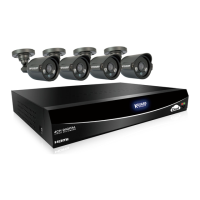
Do you have a question about the KGuard Security Easy Link EL421 and is the answer not in the manual?
| Brand | KGuard Security |
|---|---|
| Model | Easy Link EL421 |
| Category | DVR |
| Language | English |
Information about the manual's purpose, accuracy, and potential for changes or errors.
Details on equipment compliance with FCC rules for Class B digital devices.
Legal information regarding publication use, warranties, and limitations of liability.
Important warnings and safety guidelines for operating and maintaining electrical equipment.
Lists the key features and capabilities supported by the DVR device.
Details the items typically included with the DVR package for setup and use.
Identifies and describes the front and rear panel components of the DVR.
Explains how to use the USB mouse for navigating and interacting with the DVR interface.
Details the buttons and functions of the remote control for operating the DVR.
Step-by-step guide for installing a 3.5” SATA HDD into the DVR, covering 4/8 and 16-channel models.
Instructions on how to connect the DVR to a power source using the supplied adapter.
Guides on connecting the DVR display output (BNC, VGA, HDMI) to monitors.
Instructions for connecting CCTV cameras to the DVR via BNC or RS-485 connectors.
Details on connecting alarm devices and sensors, primarily for 16-channel models.
Guides for connecting microphones, speakers, and network cables to the DVR.
Information on connecting external devices like USB drives and mice to the DVR.
Steps for setting up remote live view on smart devices without complex network configuration.
Guidance on setting up cloud storage (Dropbox) for receiving DVR snapshots.
Procedures for powering on the DVR, using the startup wizard, and initial configuration.
Proper steps to safely turn off the DVR to prevent data loss or damage.
Explanation of the DVR's main interface, including screen icons and layouts.
Details on accessing the OSD menu, pop-up menus, and screen mode controls.
Instructions for controlling PTZ cameras, including zoom and cruise mode functionality.
Guide on how to manually start and stop video recording on the DVR.
Adjusting live view settings, display output, and privacy zone masking for camera feeds.
Configuring recording modes, parameters, schedules, and resolution settings.
Methods for searching, playing back, trimming, backing up, and exporting video recordings.
Setting up network connections (DHCP, PPPoE, Static IP), remote streams, email, and DDNS.
Configuring motion detection, alarm notifications, and event-triggered actions.
Managing storage devices (HDD, USB) and configuring PTZ camera settings.
Configuring date, time, user accounts, passwords, and viewing system information.
Performing firmware updates, loading defaults, managing maintenance, and event settings.
Steps to access the DVR remotely via a web browser using KGUARD Web Client.
Description of the main interface elements and navigation options in the Web Client.
Viewing live camera feeds, switching screen layouts, and controlling channels via Web Client.
Managing live channels, manual recording, and capturing snapshots through the Web Client.
Controlling PTZ cameras remotely, including pan, tilt, zoom, and focus adjustments.
Finding, playing, and downloading recorded video footage using the Web Client.
Remotely configuring display, recording, network, alarm, device, and system settings.
Setting up network connection types, ports, remote streams, email, and DDNS remotely.
Configuring motion detection zones, sensitivity, and alarm notification settings remotely.
Managing HDD, PTZ, system settings, user accounts, and viewing device info.
Performing remote firmware updates, loading defaults, and managing system maintenance.
Specifying local directories for saving downloaded videos, files, and snapshots.
Guide to installing and using the KViewQR app for easy remote viewing on smartphones.
Instructions for installing the KView Center software on Windows-based computers.
Comparison of features and compatibility across KViewQR and KView Center applications.
Addresses common problems with the DVR and provides solutions before contacting support.
Answers to common user queries regarding DVR functionality, HDD, and system access.